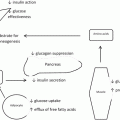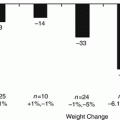Components of MS
WHO criteria (1999)
EGIR (1999)
NCEP ATP III criteria (2001)
IDF consensus (2005)
Obesity/abdominal obesity
Body mass index (BMI) ≥30 kg/m2 and/or waist-to-hip ratio >0.90 (M), >0.85 (F)
Waist circumference ≥94 cm (M), ≥80 cm (F)
Waist circumference ≥102 cm (M), ≥88 cm (F)
Waist circumference ≥90 cm (M), ≥80 cm (F)—South Asians and ethnicity specific cut points
Blood pressure
≥140/≥90 mmHg or on medication
≥140/90 mmHg or on medication
>130/>85 mmHg or on medication
>130/>85 mmHg or on medication
Fasting glucose
Diabetes, impaired glucose tolerance or insulin resistance
IGT or IFG (but not diabetes)
≥110 mg/dl or on medication
≥100 mg/dl or pre-existing DM
Triglycerides
≥150 mg/dl
TG ≥177 mg/dl
≥150 mg/dl
≥150 mg/dl
HDL cholesterol
<39 mg/dl or treated for dyslipidemia
<40 mg/dl (M), <50 mg/dl (F)
<40 mg/dl (M), <50 mg/dl (f)
Insulin-resistance
Glucose uptake below the lowest quartile under hyperinsulinemic, euglycemic conditions
Plasma insulin >75th percentile
Microalbuminuria
Urinary albumin excretion rate ≥20 µg/min or albumin: creatinine ratio ≥30 mg/g
Not in criteria
Not in criteria
Not in criteria
Metabolic syndrome—definition
Diabetes, impaired glucose tolerance or insulin resistance plus any two or more risk factors
Insulin resistance plus any two of the other risk factors
At least three risk factors
Obesity plus two of the other criteria
Apart from the above major definitions there also exist other definitions with minor variations. For instance, in 2004, the NCEP definition was revised by lowering the threshold for fasting glucose to ≥100 mg/dl according to the American Diabetes Association (ADA) criteria for impaired fasting glucose (IFG) [9]. Also the South Asian modified (SAM)—NCEP definition has been introduced for use in individuals of the South Asian ethnicity [9].
2.3 Extending the Current Definitions
Since one of the major disadvantages in diagnosing MS is the variability in the different criteria used, an attempt was made by several major organizations like International Diabetes Federation (IDF) Task Force on Epidemiology and Prevention, National Heart, Lung, and Blood Institute (NHLBI), American Heart Association (AHA), World Heart Federation, International Atherosclerosis Society, and International Association for the Study of Obesity to unify the criteria for diagnosis of MS. It was agreed upon by these organizations that though there should not be an obligatory component for MS diagnosis, waist circumference plus any combination of the other parameters would categorize an individual as having metabolic syndrome. Other than waist circumference, which is ethnicity specific, all other components would have a single set of cut points [10]. Table 2.2 describes these unified criteria in detail.
Table 2.2
Unified criteria for clinical diagnosis of MS and ethnicity specific cut points for waist circumference [10]
MS components | Categorical cut points | ||
|---|---|---|---|
Increased waist circumference Elevated triglycerides (drug treatment for elevated triglycerides is an alternate indicator) Low HDL-C Elevated blood pressure/antihypertensive drug treatment in a patient with a history of hypertension is an alternate indicator Elevated fasting plasma glucose (drug treatment is an alternate indicator) | Population and country-specific definitions ≥150 mg/dl (1.7 mmol/l) <40 mg/dl (1.0 mmol/l) in males; <50 mg/dl (1.3 mmol/l) in females Systolic ≥130 and/or diastolic ≥85 mmHg ≥100 mg/dl | ||
Waist circumference cut points for different ethnic groups | |||
Population | Organization | Recommended waist circumference threshold for abdominal obesity (cm) | |
Men | Women | ||
Europid Caucasian United states Canada European Asian (including Japanese) Asian Japanese China Middle East, Mediterranean Sub-Saharan African Ethnic Central and South American | IDF [9] WHO [11] AHA/NHLBI (ATP III) [12] Health Canada [13] European Cardiovascular Societies [14] IDF [9] WHO [15] Japanese Obesity Society [16] Cooperative Task Force [17] IDF [9] IDF [9] IDF [9] | ≥94 ≥94 (↑risk) ≥102 (↑↑risk) ≥102 ≥102 ≥102 ≥90 ≥90 ≥85 ≥85 ≥94 ≥94 ≥90 | ≥80 ≥80 (↑risk) ≥88 (↑↑risk) ≥88 ≥88 ≥88 ≥80 ≥80 ≥90 ≥80 ≥80 ≥80 ≥80 |
Initially, the criteria used for identifying people with MS were based on the data derived from Caucasian populations. Since there is sufficient evidence to prove that the currently used criteria may not be able to precisely characterize risk in non-Caucasian populations, this may result in over- or under-estimation of risk. To overcome this, we have proposed the use of a novel parameter called index of central obesity (ICO) which is the ratio of waist circumference to height [18]. Using this index could preclude the need for cut points specific for the ethnic groups. Moreover, bringing such alterations would enhance the continued feasibility, utility and sustenance of the criteria.
The IDF Consensus Group has further highlighted several other parameters that should be tested by further research to determine their predictive power [2]. Elucidating the following additional factors will facilitate the further refinement of the definition and validation of the same in the existing ethnic groups:
Abnormal distribution of body fat.
Vascular dysregulation indicated by endothelial dysfunction and microalbuminura.
Insulin resistance assessed by fasting insulin and FFA levels.
Proinflammatory state indicated by elevated hs-CRP, TNF-a, IL-6, and decreased adiponectin.
Prothrombotic state reflected by the fibrinolytic and clotting factors.
Hormonal factors in the pituitary–adrenal axis.
2.4 Use of MS for Identifying CVD and Type 2 Diabetes Risk
A number of longitudinal studies have ascribed the cardiovascular risk associated with MS. Meta-analyses have shown that metabolic syndrome was associated with a higher cardiovascular risk in women when compared to men [19]. In subjects without type 2 DM, it was shown that in the group with MS, the incidence of CVD was 10.2 % as compared to 4.9 % in the group without MS [20]. Irrespective of the definition used, MS was noted to be associated with an increased risk of CVD mortality. In non-obese men with MS, the CVD mortality after a follow-up of 10 years was found to be 1.99 % as compared to 0.53 % in those without MS [21].
Prospective studies show that MS predicts the occurrence of type 2 diabetes. Ford et al. have performed a meta-analysis on the results from 16 prospective studies and concluded that irrespective of the definition of MS, it predicted incident diabetes [22]. Also MS is closely associated with NAFLD (non-alcoholic fatty liver disease), on account of the effects of insulin resistance in increasing hepatic free fatty acid flux by inhibiting lipolysis and increasing de novo lipogenesis [23]. Thus metabolic syndrome can be considered a tool for assessment of CVD and diabetes risk. Recent studies showing an association of metabolic syndrome with polycystic ovary syndrome (PCOs) [24], Parkinson’s disease [25], and so on present the possibility of further extensions to the definition of MS and thus increase its utility as a clinical entity.
2.5 Extending MS Definitions to Children and Adolescents
Owing to the exponentially escalating rates of childhood obesity worldwide, diseases of adults have started occurring in children as well. Since the pathogenesis of obesity and metabolic syndrome are intimately interconnected, it is highly likely that the epidemic of childhood obesity would be paralleled by an increase in the prevalence of MS in this population, with grave implications for cardiovascular morbidity and mortality in the future. Though there are many difficulties in directly transposing the adult definition to children, it is commonly defined as the co-occurrence of three or more of the risk factors viz. obesity, dyslipidemia, hypertension, and impaired glucose tolerance. In utero conditions and early childhood environment have been known to predispose children to the development of the component risk factors of MS [26].
2.6 Prevalence and Long-Term Consequences of MS in Children and Adolescents
The prevalence of metabolic syndrome was found to be 38.7 % in a group of moderately obese children and 49.7 % in severely obese children in the United States [27]. In a group of Italian obese children and adolescents aged 6–16 years, the prevalence was found to be 23.3 % according to the WHO definition [28]. In a study done in 2008 on a group of African American and Caucasian children, the prevalence was found to be 18.7 %, 21 %, 13.4 %, 25.1 % by Weiss’s definition [27], Cook’s criteria [29], Cruz’s criteria [30], and Ford’s criteria [31] respectively. Despite the significant variability observed, MS was higher in the obese compared to the normal weight children and adolescents in both ethnic groups. Similarly when MS was assessed in an adolescent population using NCEP III and WHO criteria, it was found to vary from 4.2 to 8.4 % [32]. In a population of Asian Indian children, MS prevalence was found to be 2.2 by the NCEP criteria and 1.5 % by the IDF criteria in the adolescents in the age group of 16–17 years [33]. However, large population-based studies on MS are yet to be carried out in Asian Indian children and adolescents.
The presence of metabolic syndrome or its risk factors in childhood might impose long-term consequences on health during adult life; however, there are only limited longitudinal studies assessing this problem. Subjects with higher BMI, blood pressure, and triglycerides during childhood were found to develop MS in their adult life and further it was observed that a higher risk of MS was found in people in the above 75th percentile of BMI for the age and sex [34]. In the Bogalusa Heart study and the Cardiovascular risk in Young Finns Study, youth with MetS (MS) were at two to three times increased risk of having high carotid intima medial thickness and type 2 diabetes as adults, compared with those free of MetS as youth [35].
2.7 Current Definitions of MS in Children and Adolescents
There are numerous criteria existing to define MS in children, which have created a lot of ambiguity. This is evident from a review by Ford and Li (2008), which reports over 40 definitions used for diagnosis of MS [36]. In parallel, a comparative study of the existing definitions of MS in children showed that the prevalence varied between 0 and 60 % in the same sample of children [37]. This uncertainty is further compounded by the existence of different threshold values for the components of MS like obesity where cut-points like 85th, 95th, and 98th percentile of BMI have been adopted by various definitions. Tables 2.3 lists the key criteria used by various organizations for diagnosing MS in children and adolescents.
Table 2.3
Diagnostic criteria for MS in children according to the WHO, NCEP, and IDPAIA criteria
WHO [38] | NCEP [39] | IDPAIA [40] | |
|---|---|---|---|
Obesity/abdominal obesity | BMI >95th percentile | Waist >90th percentile | BMI >85th percentile |
Blood pressure | SBP >95th percentile for age, sex, and stature NHBPEP | SBP or DBP >90th percentile specific for age and sex | SBP or DBP >90th and 95th percentiles |
Fasting plasma glucose | Hyperinsulinemia Prepubertal >15 mU/l (Stage 1 Tanner) Pubertal >30 mU/l (Stages 2–4 Tanner) Postpubertal ≥20 mU/l (Stage 5 Tanner) Fasting glucose ≥6.1 mM/l Glucose intolerance glucose at 120 min ≥7.8 mM/l | Fasting glucose ≥110 mg/dl | Plasma insulin >15 μm/l |
Serum Triglycerides | >105 mg/dl for <10 years >136 mg/dl for ≥10 years | >110 mg/dl | >100 mg/dl |
Serum HDL cholesterol | HDL <35 mg/dl | HDL ≤40 mg/dl | HDL ≤ 45 mg/dl LDL >100 mg/dl |
Total cholesterol | >95th percentile | NA | >150 mg/dl |
Metabolic syndrome | Three or more risk factors
Stay updated, free articles. Join our Telegram channel
Full access? Get Clinical Tree
 Get Clinical Tree app for offline access
Get Clinical Tree app for offline access

|


